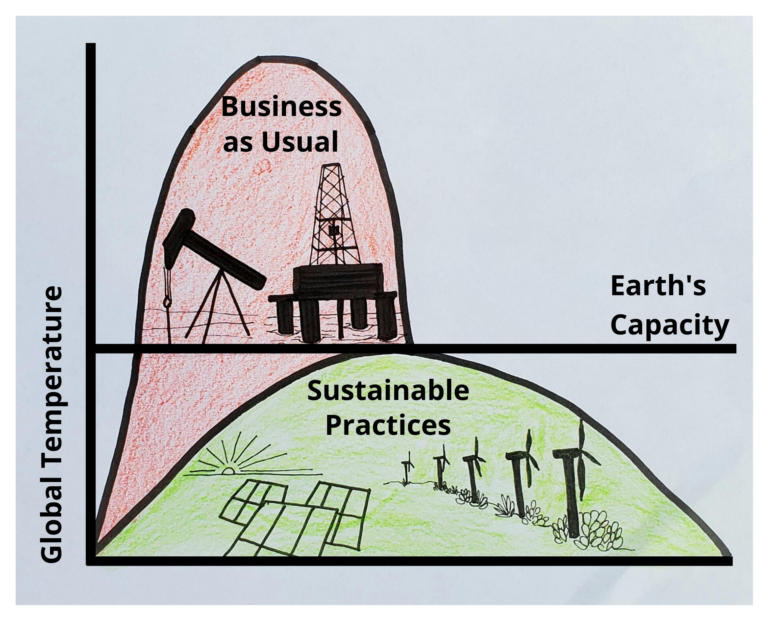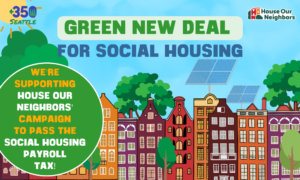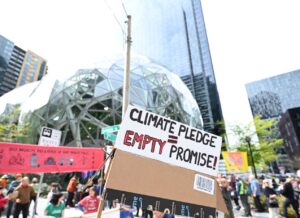by Emily Hazelton
The language of “flatten the curve,” coined during the coronavirus pandemic, holds valuable lessons about the climate crisis.
Lesson 1: System Delays
We humans are wired to handle an immediate threat. A crisis that will occur in two weeks or ten years is hard to grasp. As a climate activist, I know that we have already locked in warming of 1.5°C above pre-industrial levels. But that didn’t feel intuitive to me. Now it does.
For coronavirus, today’s actions show in two weeks, because that’s the delay between catching the virus and experiencing symptoms. Our atmosphere is complex and it takes a long time for the system to balance. Greenhouse gas emissions released today will slowly raise earth’s average temperature over the next several decades.
Lesson 2: Capacity
In Global Warming of 1.5 ºC, the International Panel on Climate Change explores two possible futures: what earth will be like with 1.5°C or 2.0°C warming above pre-industrial levels. Achieving either scenario is ambitious compared to the actions of today. We cannot proceed with business as usual.
Both scenarios are severe in their impacts to earth. But 2.0°C is unacceptable. For example, coral reefs are the forests of the ocean. Communities of fish and other sea life inhabit coral structures. Coral reefs cannot survive if ocean temperatures rise more than 1.5°C. They bleach white, and that’s how you know they’re dead. The Great Barrier Reef will not survive in the 2.0°C scenario.
The loss of biodiversity is a tragedy in itself. It also threatens our existence. As we extract oil and cut down forests, we threaten our own food and fresh water sources. We pollute the air, which causes asthma. Perhaps the source of our next vaccine goes extinct. How long can we chop at the base of the tree of life before our branch withers?
Social distancing buys time to build overflow ICUs, purchase Personal Protective Equipment (PPE), and order ventilators.
Switching our energy production away from oil and gas buys time to build up coastlines that can protect cities in big storms; adapt our agricultural practices amidst drought and floods; and allow plants, animals, and humans to migrate.
We are experiencing about 1.0°C warming now. Things will get worse before they get better. Species will go extinct. More wildfires and storms will come. But we can still control how bad it gets.
Lesson 3: Listen to the Scientists
On January 30, when there were 98 known cases of coronavirus outside of China, the Director-General of the World Health Organization declared a “public health emergency of international concern over the global outbreak.” By February 11, he had warned that the world needed to consider the virus as Public Enemy Number 1. On March 11, he assessed COVID-19 as a pandemic.
Meanwhile, on March 10, the President of the United States said, “Just stay calm. It will go away.” He did finally declare a national emergency on March 13. On April 21, the U.S. is still struggling with the availability of testing and many states lack essential equipment like ventilators and masks. Almost 789,000 people have been infected with COVID-19, the highest number of cases worldwide.
South Korea, in contrast, centered their strategy on rigorous testing and traced who may have had contact with those infected. The national government and regional municipalities worked together to share hospital beds and doctors between provinces. As of April 21, South Korea had under 11,000 coronavirus cases.
Listening to the scientists means believing their stated level of urgency and swiftly implementing suggested solutions. Staying calm will not make the crisis go away.
Project Drawdown is the world’s leading resource for climate solutions. Drawdown is the point when heating gases in the atmosphere stop increasing and start decreasing: the peak.
The Drawdown framework is comprised of three clear goals: reduce sources and bring emissions to zero, support natural carbon sinks, and improve society by fostering equality for all. The project clearly demonstrates that we already have the technology we need to make significant progress.
The scientists have told us:
- We need to ditch fossil fuels.
- We need to modify our agricultural practices.
- We need to protect and amplify nature’s ability to remove heat-trapping emissions via forests and algae.
- We need to fix and heal systems of oppression.
Lesson 4: We Can Do It
I feel awed and inspired to see how completely and swiftly humans changed to fight the spread of COVID-19. We are capable of organizing on a massive scale within a few weeks’ notice.
We’ve shown we can do it for global pandemic. Let’s do it for global warming. We can each speak up, vote, and bring change in our corner of the world.
As with fighting the pandemic, a quick response is essential in slowing the climate crisis. Each month and year of delay equates to more drastic consequences and changes later. In both cases, returning to our previous status quo isn’t possible. But by taking decisive action, we can create and thrive in a new normal.
Lesson 5: Be Human
Bringing the coronavirus curve back down is hard work. It requires lifestyle change and sacrifice.
But it also inspires creativity and brings us back to our humanity. It forces us to appreciate what truly makes life amazing: being able to breathe, flowers blooming in the spring, sunlight on our shoulders.
We sing, dance, bake, plant, and wrangle our young ones. We remember our fragility and that the health and safety of the people we love is most precious. We realize that we are all interconnected.
How do we flatten the curve of emissions and global temperature? We do it together.









